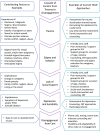"I just keep quiet about it and act as if everything is alright" - The cascade from trauma to disengagement among adolescents living with HIV in western Kenya
- PMID: 33838007
- PMCID: PMC8035676
- DOI: 10.1002/jia2.25695
"I just keep quiet about it and act as if everything is alright" - The cascade from trauma to disengagement among adolescents living with HIV in western Kenya
Abstract
Introduction: There are approximately 1.7 million adolescents living with HIV (ALHIV, ages 10 to 19) globally, including 110,000 in Kenya. While ALHIV experience poor retention in care, limited data exist on factors underlying disengagement. We investigated the burden of trauma among disengaged ALHIV in western Kenya, and its potential role in HIV care disengagement.
Methods: We performed in-depth qualitative interviews with ALHIV who had disengaged from care at two sites, their caregivers and healthcare workers (HCW) at 10 sites, from 2018 to 2020. Disengagement was defined as not attending clinic ≥60 days past a missed scheduled visit. ALHIV and their caregivers were traced through phone calls and home visits. Interviews ascertained barriers and facilitators to adolescent retention in HIV care. Dedicated questions elicited narratives surrounding traumatic experiences, and the ways in which these did or did not impact retention in care. Through thematic analysis, a conceptual model emerged for a cascade from adolescent experience of trauma to disengagement from HIV care.
Results: Interviews were conducted with 42 disengaged ALHIV, 34 caregivers and 28 HCW. ALHIV experienced a high burden of trauma from a range of stressors, including experiences at HIV disclosure or diagnosis, the loss of parents, enacted stigma and physical or sexual violence. A confluence of factors - trauma, stigma and isolation, and lack of social support - led to hopelessness and depression. These factors compounded each other, and resulted in complex mental health burdens, poor antiretroviral adherence and care disengagement. HCW approaches aligned with the factors in this model, suggesting that these areas represent targets for intervention and provision of trauma-informed care.
Conclusions: Trauma is a major factor underlying disengagement from HIV care among Kenyan adolescents. We describe a cascade of factors representing areas for intervention to support mental health and retention in HIV care. These include not only the provision of mental healthcare, but also preventing or addressing violence, trauma and stigma, and reinforcing social and familial support surrounding vulnerable adolescents. In this conceptualization, supporting retention in HIV care requires a trauma-informed approach, both in the individualized care of ALHIV and in the development of strategies and policies to support adolescent health outcomes.
Keywords: adolescent; child; mental health; patient dropouts; psychological trauma; retention in care.
© 2021 The Authors. Journal of the International AIDS Society published by John Wiley & Sons Ltd on behalf of the International AIDS Society.
Figures



References
-
- UNAIDS . UNAIDS estimates 2020. Geneva: UNAIDS; 2020. [cited 2020 Aug 18]. Available from: https://aidsinfo.unaids.org/
-
- Desmonde S, Tanser F, Vreeman R, Takassi E, Edmonds A, Lumbiganon P, et al. Access to antiretroviral therapy in HIV‐infected children aged 0 to 19 years in the International Epidemiology Databases to Evaluate AIDS (IeDEA) Global Cohort Consortium, 2004–2015: a prospective cohort study. PLoS Med. 2018;15:e1002565. - PMC - PubMed
-
- Mokdad AH, Forouzanfar MH, Daoud F, Mokdad AA, El Bcheraoui C, Moradi‐Lakeh M, et al. Global burden of diseases, injuries, and risk factors for young people's health during 1990–2013: a systematic analysis for the Global Burden of Disease Study 2013. Lancet. 2016;387(10036):2383–401. - PubMed
Publication types
MeSH terms
Substances
Grants and funding
LinkOut - more resources
Full Text Sources
Other Literature Sources
Medical
Miscellaneous

